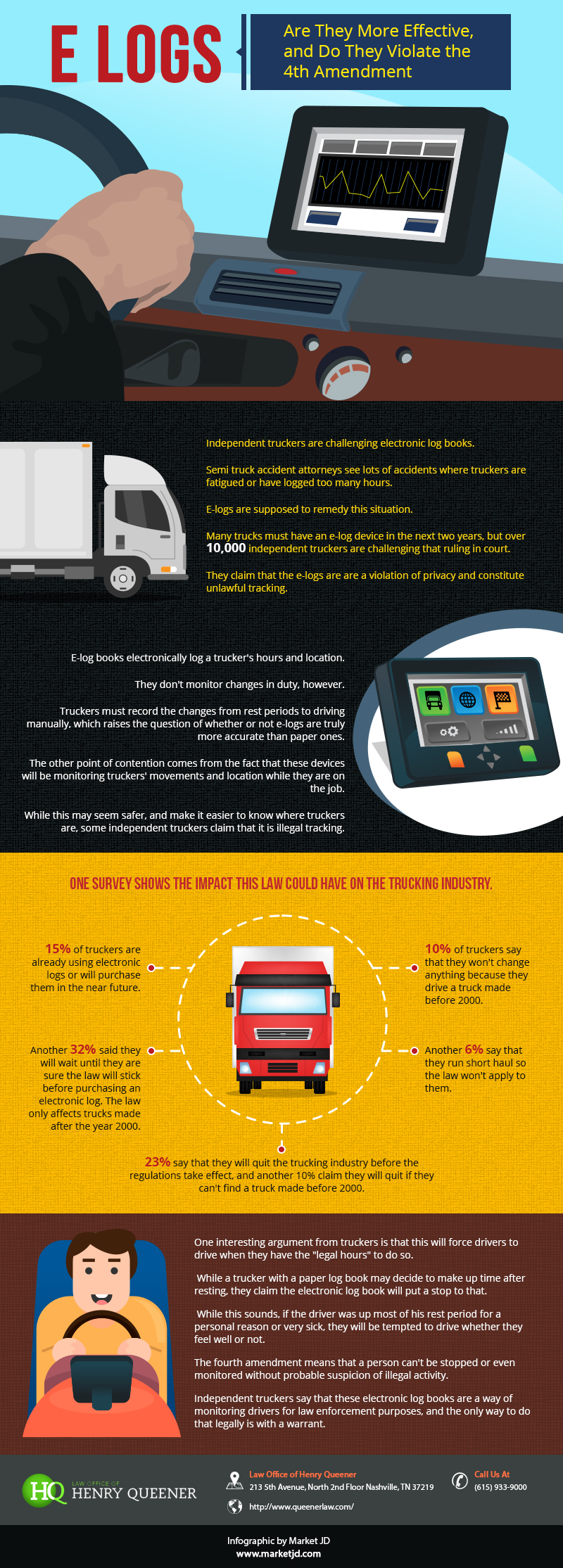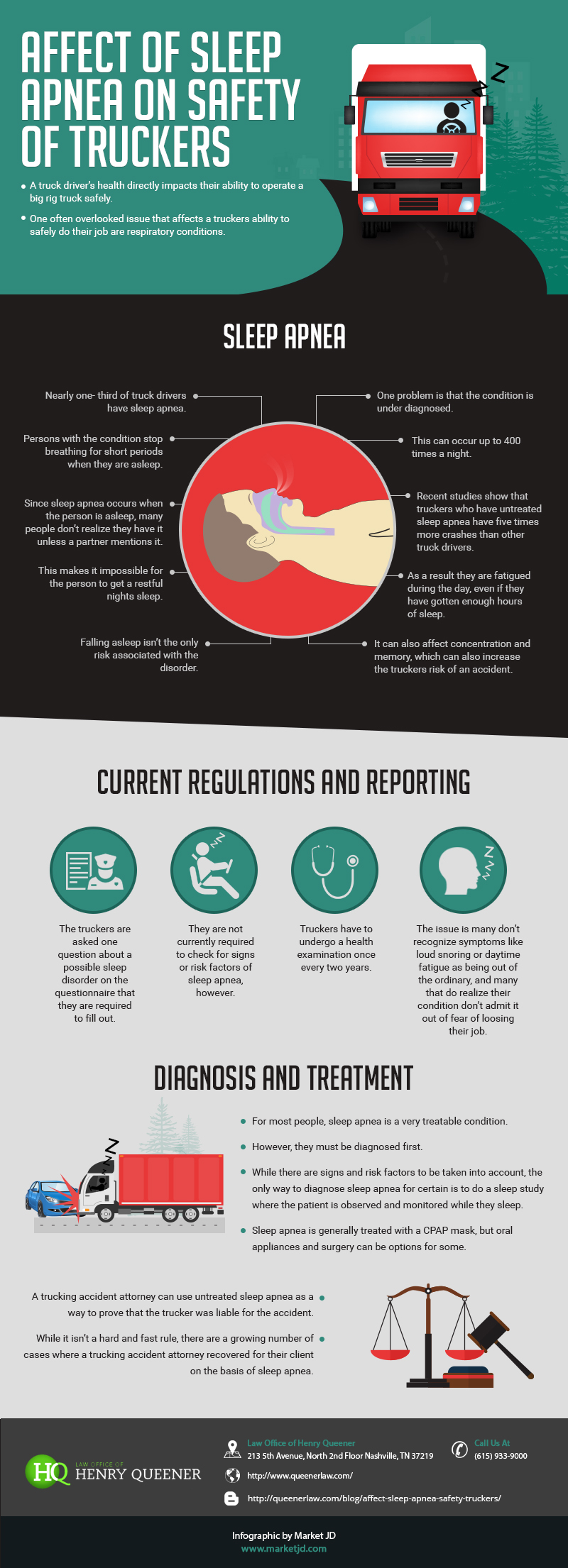
by Queener Law | Apr 10, 2016 | Colorado, Kentucky, Tennessee, Trucking Accident
Semi truck accident attorneys see lots of accidents where truckers are fatigued or have logged too many hours. E-logs are supposed to remedy this situation. Many trucks must have an e-log device in the next two years, but over 10,000 independent truckers are challenging that ruling in court. They claim that the e-logs are are a violation of privacy and constitute unlawful tracking.
E-log books electronically log a trucker’s hours and location. They don’t monitor changes in duty, however. Truckers must record the changes from rest periods to driving manually, which raises the question of whether or not e-logs are truly more accurate than paper ones.
The other point of contention comes from the fact that these devices will be monitoringtruckers‘ movements and location while they are on the job. While this may seem safer, and make it easier to know where truckers are, some independent truckers claim that it is illegal tracking.
One survey shows the impact this law could have on the trucking industry. 15% of truckers are already using electronic logs or will purchase them in the near future. Another 32% said they will wait until they are sure the law will stick before purchasing an electronic log. The law only affects trucks made after the year 2000. 10% of truckers say that they won’t change anything because they drive a truck made before 2000. Another 6% say that they run short haul so the law won’t apply to them. 23% say that they will quit the trucking industry before the regulations take effect, and another 10% claim they will quit if they can’t find a truck made before 2000.
One interesting argument from truckers is that this will force drivers to drive when they have the “legal hours” to do so. While a trucker with a paper log book may decide to make up time after resting, they claim the electronic log book will put a stop to that. While this sounds more safe, if the driver was up most of his rest period for a personal reason or very sick, they will be tempted to drive whether they feel well or not.
The fourth amendment means that a person can’t be stopped or even monitored without probable suspicion of illegal activity. Independent truckers say that these electronic log books are a way of monitoring drivers for law enforcement purposes, and the only way to do that legally is with a warrant.Categories

by Queener Law | Mar 14, 2016 | Colorado, Kentucky, Tennessee, Trucking Accident
Despite the attention that distracted driving and large truck accidents has had in the media over the last few years, and federal laws which are geared towards reducing the number of accidents due to distracted driving, recent investigations reveal that distracted driving still remains a problem for truck drivers. In fact, distracted driving plays a role in an estimated 8 percent of large truck accidents each year. While 8 percent doesn’t seem like a number of much magnitude, when an individual considers that there are approximately 4,000 fatalities due to large truck accidents in the United States each year, and an estimated 284 injuries each day caused by accidents with big rigs, 8 percent is actually a large number.
Since safety advocates first began evaluating the issue of distracted driving and the big rigs, the use of cellphones has been a major focus. In 2012, a federal law went into effect banning the use of handheld cellphones while operating a commercial truck. The law includes interstate truck drivers and bus drivers as well as drivers who transport “placardable quantities of hazardous materials”.
The Dangers of Using Cellphones While Driving
Countless commercial vehicle drivers still use their cellphones regularly while driving, but the effects of doing so can be catastrophic.
- Research shows that commercial motor vehicle operators who use their cellphones to text while driving are 23 times more likely to become involved in an accident or safety critical event than drivers who did not text and drive.
- Truck drivers who use their cellphones to place or receive calls and performed other operations that required dialing were 6 times more likely to experience an event than those who avoided such cellphone usage.
- Drivers who reach for a cellphone or other object in such a manner that interferes with a safe driving position are approximately 7 times more likely to become involved in a safety critical event.
Drivers typically take their eyes off of the road for between 3.8 and 4.6 seconds when texting or dialing. During that short period of time a commercial vehicle traveling approximately 55 mph. will cover more ground than a football field- an estimated 300 ft.
While using handheld devices is strictly prohibited, using them in a hands-free manner is generally acceptable. Any hands-free device needs to be within close proximity to the trucker. Additionally, the federal regulations regarding cellphones do not apply to devices used for dispatching unless texting is involved.
The Penalties for Driving and Using Cellphones
For those who are caught texting or using handheld cellphones while operating a motor vehicle, the penalties can be severe.
- Drivers can face fines of up to $2,750
- Second and subsequent offenses can result in the truck driver being placed out of service for up to 120 days.
- Violations will have a negative impact on the employer’s Safety Measurement System rating.
- Employers can be fined up to $11,000 if they require or knowingly allow their truck drivers to text or use hand-held cellphones while operating a commercial vehicle.
- Violations of the law are considered to be serious traffic violations and penalties are taken with consideration of the existing Federal Motor Carrier Safety Administration guidelines.
In addition to the above stated penalties, drivers who violate the law could be subject to whatever punishments their employer wishes to dish out in accordance to their own policies. Since many companies have policies that are similar to those regulations set forth by the federal law, and truckers who use handheld cellphones while driving are at a higher risk for accidents, they are like lawsuits waiting to happen. Termination of employment upon violation of the law is common.
Although many states have not set their own laws regarding commercial vehicles and cellphone usage, truckers should be aware that they are still required to follow the regulations set forth by the federal law when traveling interstate, regardless of the state they are in.
Other Forms of Distracted Driving Among Truck Drivers
Unfortunately, using cellphones while driving is not the only form of distracted driving that effects truckers and their risk of accidents. The unique lifestyle that goes along with trucking brings with it a strong temptation, and sometimes necessity, to perform other tasks while driving. Two of the more common distractions among truckers are:
- Eating or Drinking: Due to strict deadlines, many truckers don’t have the time to pull over and eat when they are hungry. Therefore, they often grab something to go and eat on the road to make deliveries on time.
- Reading Maps or GPS Screens: Since truckers often travel in areas that they are unfamiliar with, it is an extremely common practice for them to take their eyes off of the road to look at directions.

by Queener Law | Mar 14, 2016 | Colorado, Kentucky, Tennessee, Trucking Accident
A truck driver’s health directly impacts their ability to operate a big rig truck safely. One often overlooked issue that affects a truckers ability to safely do their job are respiratory conditions.
Sleep Apnea
Nearly one third of truck drivers have sleep apnea. One problem is that the condition is under diagnosed. Persons with the condition stop breathing for short periods when they are asleep. This can occur up to 400 times a night. Since sleep apnea occurs when the person is asleep, many people don’t realize they have it unless a partner mentions it. Recent studies show that truckers who have untreated sleep apnea have five times more crashes than other truck drivers.
This makes it impossible for the person to get a restful nights sleep. As a result they are fatigued during the day, even if they have gotten enough hours of sleep. Falling asleep isn’t the only risk associated with the disorder. It can also affect concentration and memory, which can also increase the truckers risk of an accident.
Current Regulations and Reporting
Truckers have to undergo a health examination once every two years. They are not currently required to check for signs or risk factors of sleep apnea, however. The truckers are asked one question about a possible sleep disorder on the questionnaire that they are required to fill out. The issue is many don’t recognize symptoms like loud snoring or daytime fatigue as being out of the ordinary, and many that do realize their condition don’t admit it out of fear of loosing their job.
Diagnosis and Treatment
For most people, sleep apnea is a very treatable condition. However, they must be diagnosed first. While there are signs and risk factors to be taken into account, the only way to diagnose sleep apnea for certain is to do a sleep study where the patient is observed and monitored while they sleep. Sleep apnea is generally treated with a CPAP mask, but oral appliances and surgery can be options for some.
A trucking accident attorney can use untreated sleep apnea as a way to prove that the trucker was liable for the accident. While it isn’t a hard and fast rule, there are a growing number of cases where a trucking accident attorney recovered for their client on the basis of sleep apnea.

by Queener Law | Mar 8, 2016 | Colorado, Kentucky, Tennessee, Trucking Accident
On December 4, 2015, President Obama’s signature placed the Fixing America’s Surface Transportation (FAST) Act into law just a day after the House of Representatives passed the Act 83 to 16 in a race to beat the date of the expiration of the current funding extension. The impressive 1,300 page legislation is the first long term solution to settling highway and funding issues in more than a decade. The five year Bill will provide $305 billion in funding for roads, bridges and mass transit.
Additionally, the Act will include a number of regulatory reforms on the trucking industry. On Tuesday, December 1, 2015, the Executive Vice President of the Owner-Operator Independent Drivers Association, Todd Spencer stated that he believed the Act was a positive compromise.
Effects of the Fast Act on the Trucking Industry
At first glance, most of the provisions that were proposed by both sides appeared to have a fighting chance. Some of the items that were on the trucking industry’s wish list and that of safety advocates were omitted from the final Bill, however.
- The trucking industry had asked that federal law allow truckers as young as 18 to operate trucks across state lines. While advocates for the provision claimed that doing so would solve the issue of a long time shortage of truck drivers, safety advocates who opposed the provision cited studies that suggest that younger, less experienced drivers are at a significantly higher risk of being involved in a trucking accident. Instead of including the provision in the Bill, the Act sets up a controlled study that is to be conducted by the FMCSA to determine the benefits and safety impacts of allowing young drivers to join the long haulers.
- While some lawmakers and lobbyists were pushing for more lenient regulations with regards to maximum truck weights and sizes, no measures to change federal weight and size regulations were included in the Bill. Those in favor were asking for weight limits of 91,000 pounds and increased tandem truck length maximums to be raised to 33 feet.
- Some safety advocates had asked that the Bill include language that required that brokers, shippers and others to hire only carriers with satisfactory safety ratings. Since an estimated 400,000 small trucking companies and owner-operators are not rated by the FMCSA, doing so would have put a damper on the business opportunities for these groups. The Hiring Standards provision, therefore, was not included.
- It had been proposed that the current minimum liability insurance limit be raised from its current amount of $750,000. Instead, the Act requires that an investigation be completed that will help determine if the minimum should be raised in the future.
A number of new regulations that will affect the trucking industry did make it into the Act, however. Some of the more important on the list include:
- Much needed CSA reform is in the near future. Until the faults of the program are evaluated and fixed, certain information will no longer be available to the public regarding carriers’ rankings. Some information, like violations and inspection data are stipulated to remain in public view.
- Drug testing in the trucking industry is destined to undergo change. Employers will now have the ability to use hair tests in lieu of urine tests to make overall testing results that report average usage more accurate. Hair testing will be a powerful tool that helps carriers keep habitual drug users off the nation’s roads. Within one year of the Bill’s enactment, the federal Department of Health and Human Services (DHHS) is to provide established guidelines for hair testing.
- While more lax regulations pertaining to driver rest periods and maximum work hours did not make it into the Bill, the Act requires that the FMCSA conduct a study that evaluates how delays during loading and delivery impact a driver’s schedule, performance and pay. The study will also reveal how detention times effect the flow of U.S. freight.
- The Bill requires that the FMCSA reform the rules that govern commercial driver’s license (CDL) issuance. The new law will allow military veterans who have experience operating large equipment that is comparable to heavy trucks to more easily obtain civilian truck driving jobs. It will also allow military veterans to use their experience that was obtained in the military to count towards required skills tests. The Bill will also allow military veterans to obtain their required medical certification from Veterans Affairs doctors rather than only from those in FMCSA’s National Registry of Medical Examiners.
- Tow truck drivers who are removing heavy trucks and other large equipment fromaccidents and emergency situations will now be exempt from federal weight limits on federal roads. The tow trucks must deliver their load to the nearest available repair center, however.

by Queener Law | Mar 3, 2016 | Colorado, Kentucky, Tennessee, Trucking Accident
An alarming 4,000 Americans lose their lives to accidents involving large trucks each year, and an additional 85,000 are injured. While there are numerous causes that result in such high numbers of truck accidents, perhaps one of the most disturbing is drug and alcohol use. According to a recent study, truck drivers are now engaging in drug use, including the use of amphetamines, cocaine, alcohol, marijuana, and over the counter stimulants in horrifyingly high numbers.
The study, which developed the majority of its information from conducting voluntary, international surveys, performed drug tests on many if its participants to help obtain more accurate results. The findings are shocking.
- Nearly 50 percent of drivers who were surveyed admitted to driving while under the influence of alcohol. According to a report by the Federal Motor Carrier Safety Administration FMCSA), a whopping 2.1 percent of large truck drivers who were involved in fatal accidents in 2012 alone had a blood alcohol concentration (BAC) level of 0.08 or higher. Additionally, some level of alcohol was detected in the blood of an alarming 3.5 percent of big rig drivers who were involved in fatal accidents in 2012 as well.
- Approximately 35 percent of truck drivers who are involved in fatal accidents go on to test positive for the presence of illegal drugs, and an estimated 33 percent of those who are involved in fatigue related accidents test positive as well.
- 30 percent of truck drivers who were surveyed admitted to using amphetamines, 20 percent use marijuana, and 3 percent admit to using cocaine.
Another recent study reports that 85 percent of truck drivers who were surveyed claimed that methamphetamines, drugs that are prevalent among big rig drivers, are readily available at most truck stops.
Why Such a Need for Speed and Other Drugs
The National Transportation Safety Board of the United States has been evaluating the issue for more than 25 years and it is obviously one of major concern. The use of drugs and alcohol while operating the big rigs poses a dangerous risk to truckers themselves, other drivers who are sharing the road, and even to pedestrians, bicyclists and motorcyclists. Despite the unfortunate impact driving while impaired has on public safety, however, there are relatively few studies that focus on preventing the situation at hand. Such a small number of studies makes identifying the risk factors, causes, and those drivers who are more susceptible very difficult.
Fortunately, the study referred to above, published in 2013, focused on the factors associated with truck drivers’ alcohol and drug use to help everyone take a better look at what could be causing such terrifying statistics. Here is what they found.
- One of the main factors that were associated with psychoactive substance use among truckers is long work hours. Although truck drivers and trucking companies alike can benefit financially from truckers working longer hours, going without sleep or adequate rest periods can tempt truckers to reach for alternative ways to stay awake. Meth, cocaine, and other illegal and even over the counter stimulants enable truckers to avoid sleep for longer periods of time, thus they log more miles and make deliveries earlier. Unfortunately, driving under the influence of such stimulants has been proven to increase the risk of becoming involved in devastating accidents. Additionally, driving while coming down from these drugs can be just as dangerous, causing fatigued drivers to drift off or fall asleep at the wheel.
- Sadly, the pressures and daily demands involved with being a truck driver can take their toll, causing many to turn to alcohol or drugs as a means to escape or relax. When truckers succumb to the temptation to use illicit drugs or alcohol, they place their careers, as well as their lives and the lives of other in jeopardy. Drug and alcohol use by truckers is the second largest contributing factor in trucking accidents.
- Younger truck drivers, and those who are separated or divorced tend to use drugs and alcohol while driving more frequently than those who are more mature, married or in meaningful relationships.
While many people believe that driving under the influence of stimulants or marijuana is far less dangerous than drinking while driving, that belief is simply not true. The effects of alcohol, while significantly impairing, only last a few hours after consumption. The effects of many other types of drugs can effect reaction times, perception, decision making abilities, and concentration for much longer. Fortunately, the FAST Act has enabled trucking companies to conduct hair testing in lieu of urine testing as a means of obtaining more accurate long term usage information about their drivers. Unfortunately, some smaller trucking companies never even bother drug testing their employees.

by Queener Law | Feb 28, 2016 | Colorado, Kentucky, Tennessee, Trucking Accident
Every year, about 500,000 large truck accidents occur in the United States, according to the U.S. Department of Transportation. About one percent of these result in fatalities. Nearly all of those killed in trucking accidents are in passenger vehicles, and even though truck drivers are safer drivers than the average commuter, they still present a huge danger on the road.
Recent legislation passed in the U.S. House risked making truck accidents even more likely in 21 states around the country that require truckers to take regular rest and meal breaks, much like workers in other industries. The amendment in a massive six-year transportation bill was ultimately removed from the bill. This is fortunate, as driver fatigue is one of the top causes of trucking accidents.
Rest Increases Driving Safety
The likelihood of the need to contact a truck wreck lawyer increases when truckers drive tired. According to an Australian study, being awake for eighteen hours causes a driver to act like someone with a .05 blood alcohol content. Pushing that to 24 hours makes the driver even worse than a legally drunk person. People who sleep less are also more likely to crash. Those that sleep fewer than five hours each night are five times more likely to have an accident than someone who averages eight hours of sleep per night.
A complete study of the causes of trucking accidents found that driver fatigue is the lead cause in 13% of all large truck accidents. While passenger vehicle drivers are twice as likely to have fatigue cause an accident, if it could be removed as a cause of truck accidents there is the potential for saving many lives each year and reducing the amount of injuries as well.
Even a 50% decline in fatigue related trucking accidents could save around 200 lives on U.S. roads. Unfortunately, less than half of all states require that truck drivers take mandatory breaks for rest and meals. Most truck drivers do take care of their health by getting enough sleep and taking breaks when necessary. State trucking policies do not encourage drivers to do so however. A truck wreck lawyer could confirm that one small mistake on the roads can be catastrophic when it involves a large truck. Truckers should be encouraged to operate safely and at their best, not while tired and hungry.






